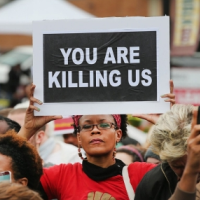Shootings by L.A. Police Are Nearly Double This Year, but Info Is Limited
 (photo: Scott Olson, Getty Images)
(photo: Scott Olson, Getty Images)
Shootings by Los Angeles police officers have nearly doubled this year, to 45, according to the city's police commission, and 19 civilians have been killed.
But, in keeping with the nation's practice of secrecy about police shootings, those were about the only numbers made available during a wild commission meeting Tuesday attended by Black Lives Matter and other activists. At one point, a number of them were escorted from the room.
Matt Johnson, appointed to the commission by Mayor Eric Garcetti in September and immediately elected president by his four colleagues, proposed that the “alarming development” be aggressively studied. He asked for a report that analyzed officer-involved shootings over decades of time and reviews of the department's use of training, technology and weapons, including Tasers and beanbag shotguns.
The Los Angeles Times characterized the effort as a radical shift beyond the commission's usual limited incident-by-incident examination of violent encounters involving the police. Johnson, the only black member of the commission, is a 47-year-old entertainment lawyer who moved to Los Angeles from New Jersey in 1992, three weeks after the Rodney King riots.
Police departments tend not to release reports to the public or federal authorities on police shootings. It's why the U.S. Department of Justice (DOJ) does not have meaningful statistics on patterns of shootings over time, that break out incidents by race, armed status of the civilian or the prosecution of officers.
High-profile shootings by newly-militarized police have rocked the nation, shining a spotlight on how little the public knows about police practices. The debate over the latitude given the police by U.S. Supreme Court rulings and local policies has been hamstrung by the lack of relevant data.
National Public Radio (NPR) tellingly reported matter-of-factly in a story about law enforcement shootings that “the federal government isn't about to require police agencies to start reporting these numbers,” as if the idea were too absurd to actually consider. Instead, the Bureau of Justice Statistics has started a pilot program to use open source data, like reports gathered by news agencies, to get a picture of the problem.
That would include data like that gathered by local NPR affiliate KPCC in Los Angeles. The news outlet built a database of officer-involved shootings in all of Los Angeles County between 2010 and 2014. KPCC used data from the county district attorney's office and the coroner to identify 375 shootings over the five years.
No officers were prosecuted. One in four suspects was found to be unarmed. Although 8% of the county population is black, 24% of the shooting victims were African-American. Police can legally justify their actions based on the behavior of the victim. KPCC found that police claimed 148 people were shot for reaching toward their waistband or moving their hands out of sight. Forty-seven were found to be unarmed.
‒Ken Broder
To Learn More:
LAPD Police Commission: Officer-Involved Shootings Double, Data Still Limited (by Annie Gilbertson, KPCC)
Shootings by LAPD Double in “Alarming” Trend, Police Commission President Says (by Kate Mather, Los Angeles Times)
In Los Angeles, Piecing Together The Numbers On Police Shootings (by Martin Kaste, NPR)
Officer Involved (by Annie Gilbertson, Rina Palta and Frank Stoltze, KPCC)
- Top Stories
- Controversies
- Where is the Money Going?
- California and the Nation
- Appointments and Resignations
- Unusual News
- Latest News
- California Forbids U.S. Immigration Agents from Pretending to be Police
- California Lawmakers Urged to Strip “Self-Dealing” Tax Board of Its Duties
- Big Oil’s Grip on California
- Santa Cruz Police See Homeland Security Betrayal in Use of Gang Roundup as Cover for Immigration Raid
- Oil Companies Face Deadline to Stop Polluting California Groundwater





